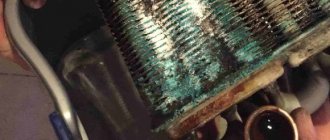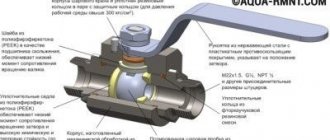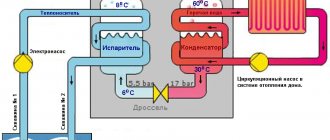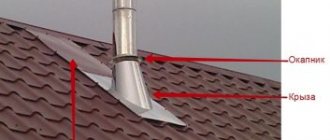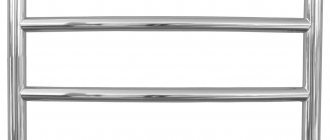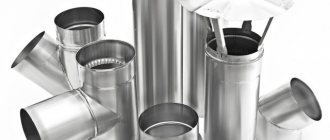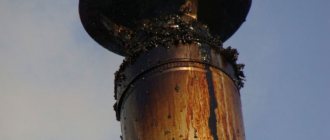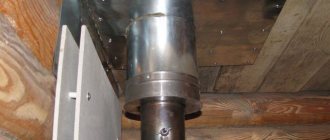A situation where a pipe on the roof is leaking, or there are leaks in the roof near it, requires immediate intervention. Otherwise, such damage to the roof can lead to harmful consequences. Fortunately, fixing such a defect with your own hands is quite simple. The main thing is to decide how to seal the gap between the pipe and the roof. To do this, you need to choose the right method to eliminate the cause of the leak, determining the location of the leak and preparing the required materials, which must be selected taking into account the type of pipe and roof.
Why does condensation appear?
Condensation in the chimney pipe can form for the following reasons:
- The chimney pipe is clogged. The accumulation of blockages leads to a decrease in draft, which is why the heated gas does not move through the pipe as quickly as it should. As a result, it interacts with air, which leads to condensation.
- Temperature difference when gas exits. In winter and autumn, the temperature inside the chimney is quite low. When heated gases rush into it, a wet sediment forms.
- Significant fuel moisture. To heat a private home, it is recommended to use well-dried firewood or other types of fuel. Otherwise, when exposed to fire, internal moisture begins to evaporate, followed by its settling inside the chimney.
- External influences. This mainly happens due to precipitation if it has the opportunity to get inside the chimney.
It is important to know how to get rid of condensation in a chimney pipe. These problems in the chimney pipe are eliminated by cleaning it, insulating it or protecting it from precipitation. The method is selected depending on the identified cause of this phenomenon.
How to quickly fix a chimney leak
Leaking of a pipe or the area of the roof adjacent to it is a fairly common problem. In such cases, they usually call a specialist, but, in principle, you can fix the problem on your own. The main thing is to correctly determine the cause of the defect and be quite careful during the repair process. Working at height is always dangerous, so be as careful as possible. Never forget about proper insurance.
Chimney pipe cleaning
If condensation in the chimney occurs due to its clogging, it is necessary to clean it.
Methods for cleaning a chimney:
- Using special chemicals, the combustion of which causes the decomposition of soot deposits. These include the “Chimney Sweeper” product.
- By mechanical cleaning.
- Folk remedies.
Manual cleaning is carried out using a cable (rope) of suitable length, a weight (as a weighting agent) and a special brush. This device must be smoothly lowered inside the smoke channel from above. As for folk remedies, ordinary salt or potato peelings are used for this, throwing them into the firebox while the fire is burning. Regardless of the chosen method, compliance with safety rules is required.
The roof of the chimneys is leaking: what to do? Let's fix it!
Almost always, roofing work cannot be done without the use of special devices and materials - additional products. They allow you to install all the joints carefully and correctly when installing the roof.
But, despite the efforts of roofers to install the roofing material according to the technological process, sometimes water leaks appear at the joints near the chimney.
Eliminating such a defect is quite simple for craftsmen, however, it is often possible to do it yourself. First you need to decide how to seal the joint between the pipe and the roof. What material is required to effectively seal a leak?
Chimney insulation
What to do if the chimney pipe leaks mainly during the cold periods of the year? The reason for this is most often its insufficient insulation. The thermal insulation material in this case can be mineral wool, any fibrous insulation, polystyrene foam boards, or plaster. Metal or asbestos-cement pipes are usually finished with mineral wool and fibrous materials. To insulate a brick chimney, it is better to choose plaster.
Finishing a chimney using fiber insulation or mineral wool is carried out as follows:
- First, the material is cut into pieces convenient for wrapping.
- The prepared pieces are fixed to the surface of the pipe using metal wire or clamps.
- For external protection of the laid thermal insulation, a metal box or foil is usually used.
To plaster a brick chimney, you will need to do the following:
- The wall of the brick pipe must be pre-equipped with a plaster mesh, for which special bolts with an enlarged head are used. This is done in order to increase the adhesion of the solution to the surface to be finished.
- The composition of the first applied layer includes cement, lime, water and fine slag. It is usually made up to 40 mm thick.
- When the starting layer has dried, you can apply the rest, 3-5 pieces.
- Upon completion of the plaster, you need to wait until the material has completely dried, and then paint it decoratively in any suitable color. It is believed that the plaster insulating a pipe should consist of at least 7 layers.
Round pipes - roof seals (cost)
Sandwich pipes are often used. They are affordable and practical. For a round pipe and its waterproofing, roofing seals made of rubber or silicone are used.
They can be installed at any time of the year. No need for special installation skills and tools. There is also no need to do additional waterproofing.
The protection device is a pyramid with steps on a rectangular base. It is suitable for pipes of any diameter and for any type of roof. Silicone
The seals can withstand temperatures up to 240 degrees.
Rubber
analogues are used where the gas temperature is no more than 120 degrees. Devices with reinforced metal will last longer, but do not adhere well to the roof topography.
The rubber penetration is ideal for sandwich chimneys. For stainless steel chimneys, heat-resistant silicone penetrations are used.
There are straight and angular versions of the Master Flash design available for sale. The direct option is relevant when the roof has a slope of up to 20 degrees. First, the device is secured with sealant, and then secured with screws. Corner option for roofs with a slope of more than 20 degrees.
Price
roofing cuff from 1000 rubles. In Leroy Merlin, a corner roofing seal costs 1,500 rubles, and a straight seal costs 1,300 rubles.
Source
Protection of the smoke channel from precipitation
This is done using caps specially designed for this purpose, which are equipped with the tops of chimneys.
Some head models have built-in deflectors inside: this allows the product not only to perform protective functions, but also to help increase traction. In the same way, you can reduce condensation in the chimney pipe of a gas boiler.
Preventive actions
To reduce the percentage of condensation inside the chimney, carry out the following actions:
- The brick chimney duct is equipped with a metal pipe (the so-called “sleeving”). This makes cleaning the channel from soot much easier. In addition, this seals and insulates it: in this case, condensation occurs in noticeably smaller quantities, and it is removed faster.
- Install a special device for collecting condensate. It is best to do this at the place where the vertical and horizontal parts of the channel intersect: this is where it is most convenient to remove moisture from the gas flow. During maintenance of the condensate collector, it will be necessary to remove accumulated water from it from time to time.
- Use well-dried high-quality fuel.
- Carry out regular cleaning activities. The best time for this is mid-autumn, ahead of the start of the heating season.
- If necessary, repair the chimney.
Even if all the above recommendations are strictly followed, this will not guarantee the complete absence of condensation in the chimney, since this phenomenon will in any case accompany the operation of the furnace equipment. However, significantly reducing the percentage of moisture loss is a completely feasible task: this will increase the efficiency of the system and extend its service life.
Solution to the problem.
To seal the passage of a sandwich chimney through the roof, a special engineering element “Master-flash” is used.
Master Flash is a special sealing cuff with high elasticity.
This element can withstand high temperatures and is resistant to frost and ultraviolet radiation.
Master flash is glued to the sealant and secured to the metal roof with flat-headed self-tapping screws.
Here, to be more sure, I additionally taped the connection between the master flush and the roof with bitumen tape.
Bitumen tape is a reliable tool.
The top of the tape is a film, and the bottom side is a bitumen base.
The color of the tape is different, you can match it to any roof.
The base of the tape is glued to the metal easily and reliably.
But it’s better to glue it to warm metal, so in winter you’ll have to warm the roof with a hairdryer.
In principle, using tape, you don’t even have to glue the master flush onto the sealant, but to be sure, I use both.
Now the connection between the master flush and the roof will be airtight, however, water will still flow inside the castle, between the sheets.
Moreover, the smaller the slope and the greater the distance to the pipe, the more water will end up inside the castle.
And in this place it always starts to flow.
I even tried sealing the entire castle, the result was the same, the roof began to leak.
The only correct solution is to completely cover the lock from above from the ridge to the pipe.
To do this, I use a smooth sheet that matches the color of the roof.
In fact, it doesn’t matter what you cover the castle with, here I covered it with a smooth sheet in the color of the roof.
Someone covers it with a sheet of metal tiles, the main thing is to cover the lock.
Source
How and what to use to fix a leak on the roof near the pipe?
A situation where a pipe on the roof is leaking, or there are leaks in the roof near it, requires immediate intervention. Otherwise, such damage to the roof can lead to harmful consequences. Fortunately, fixing such a defect with your own hands is quite simple. The main thing is to decide how to seal the gap between the pipe and the roof. To do this, you need to choose the right method to eliminate the cause of the leak, determining the location of the leak and preparing the required materials, which must be selected taking into account the type of pipe and roof.
Sealing cracks in slate roofing
If it is necessary to seal a gap in a slate roof, an asbestos-cement mixture is used. The process technology is as follows:
- A round hole is cut in a steel sheet, which is used to finish the ridge.
- A ring of sheet asbestos cement is placed on the pipe.
- For complete tightness, it is necessary to seal the joint between the pipe and the roof with a solution of cement and asbestos, which are diluted in a ratio of 1 to 2.
- It is also necessary to fill the gap between the chimney pipe and the slate sheet with asbestos-cement mortar. For this purpose, you can make a temporary limiter from cardboard.
Repairing pipe leaks on the roof
Before answering the question of what and how to fix a leak on the roof near the pipe, you need to decide what material it is made of. It is very important. This is the starting point for repair work.
The chimney duct can be mounted from the following materials:
When eliminating a leak, you need to follow a certain sequence of actions, which can differ significantly for each chimney material. Therefore, the technology for eliminating such defects for each type of pipe should be considered in detail.
Fixing brick chimney leaks
If a pipe made of red brick is leaking on a roof, then to fix the problem you will need the following materials and tools:
- cement grade M 400 or M 500;
- sand, preferably river or sea, but quarry sand is also suitable;
- water;
- Master OK.
How to seal the gap between the pipe and the roof, having all of the above? You must adhere to the following sequence of actions:
- A cement mortar is made from the prepared materials by mixing 3-4 parts of sand and one part of cement;
- the detected leak site is thoroughly cleaned of dirt and remnants of destroyed bricks;
- The prepared mixture is applied using a trowel to the damaged areas.
It is better to repair a roof pipe in sunny, dry weather. This way the cement mortar will harden much faster.
Repairing metal chimney leaks
If a metal chimney is leaking, then to correct the current situation you will need:
- special clamps with a rubber gasket that can be secured to the pipe where the gap occurs. The diameter of the clamp should be approximately equal to the thickness of the pipe. Its width should be slightly larger than the size of the crack;
- in addition, small cracks can be eliminated using cold welding, instructions for use of which can be found on the packaging.
The specified materials for eliminating metal pipe leaks can only be used as a temporary measure. As soon as possible, the damaged section of the chimney must be replaced with a new one.
Repairing asbestos chimney leaks
If water flows through an asbestos pipe, then you can eliminate the leak by performing a number of the following actions:
- First of all, you need to stock up on cotton fabric and “Iron Lead” paint. You can buy such materials at any hardware store;
- then the chimney, namely the damaged area, should be cleaned of dirt and dust;
- the paint is applied in a thick layer;
- fabric is tightly wrapped over it;
- Then the paint and varnish material is reapplied.
For the most part, such repairs are also a temporary measure that allows you to postpone the replacement of the chimney pipe for a certain period. You should not delay replacing a damaged asbestos chimney.
Material for waterproofing bitumen roofs
The method described above is not the only solution to the problem, how to seal the pipe on the roof?
If the pipe is round, then you can use the Master-Flash universal nozzle. This nozzle is designed for sealing various connections and can be used not only for installing chimney pipes, but also for connecting antennas, ventilation pipes, fixtures, etc.
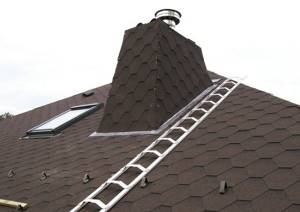
Sealing the chimney pipe casing
The universal penetration looks like a stepped pyramid. When using this device, the question of how to seal the gap between the pipe and the roof is solved easily and quickly.
The penetration is made of silicone or a special type of rubber, and the base has a two-layer: the lower part is aluminum, the upper part is made of high-quality silicone.
If the penetration is made of EPDM rubber, then it can be operated in the temperature range of -55 - 135 ° C; when choosing a silicone model, the temperature range of use is even wider (-74 - 260 ° C).
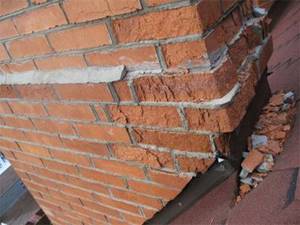
This roof chimney seal can be used when using any roofing material.
Advantages of the “Master Flesh” penetration:
- Durability;
- UV and weather resistance;
- Ease of installation;
- Can be used with different pipe diameters.
On sale you can find 11 varieties of “Master Flash” penetrations, differing from each other in the diameter of the hole for the pipe.
Installing a chimney is usually not a difficult process, however, in some places, such as floor crossings, some difficulties may arise. An important point is to ensure proper waterproofing. We will talk about this and other nuances related to how to seal a chimney pipe in this article.
Sometimes the question arises of how to seal the gap between the pipe and the slate.
The technology provides the following sequence:
- First, a round hole is cut in the steel sheet that will be needed to finish the ridge.
- Next, a ring of sheet asbestos cement is placed on the pipe.
- For absolute sealing, so that in the future there will be no problems with the leaking pipe on the roof, the joint between the pipe and the roof is sealed with an asbestos cement solution (proportion 1:2).
- In addition, the same solution is used to fill the gap between the chimney pipe and the slate sheet. To do this, you can temporarily make a limiter out of cardboard.
On a tile roof, it is best to seal the cracks with a solution of sand and cement, which will best protect the inside of the building from moisture and precipitation.
To achieve the best moisture insulation, you will need:
- Install a galvanized collar on the roof, thus creating a place for pouring the solution.
- Pour a solution of cement and sand, making sure that it clearly fills the entire space between the roof and the chimney.
- In addition, you will need to make a surface and place it at an angle so that excess liquid flows down it.
Among the options for covering a pipe on the roof if it rises above a bitumen roof, the most optimal is the use of Wakaflex self-adhesive tape.
You can perform isolation in this way:
- First, cutting is done from the Wakaflex tape.
- At the next stage, this cutting needs to be pressed with a pipe case.
- At the end, all remaining gaps between the parts being connected are sealed with bitumen mastic.
Repairing leaks near a pipe
If water flows through the chimney during snow melting or rain, the reason for this is a violation of the tightness in the place where the pipe and the roof are connected. If there is a roof leak near a pipe, there are a number of ways to fix the existing problem:
- apply bitumen tape;
- install rubber cuffs;
- make and install a metal apron.
All of the above methods allow you to close the leak, so they should be considered in more detail.
Using bitumen tape
If a chimney leaks due to rain or melting snow, then the simplest and cheapest way to eliminate the leak is to make an apron from bitumen tape. To perform such work you need to use the following materials and tools:
- bitumen tape;
- scissors;
- metal brush;
- gas burner.
The cracks are sealed by taking the following measures:
- first you need to use a metal brush, which is used to clean the roof around the chimney and its outer lower part;
- Remove any remaining dust and dirt with a damp cloth;
- At the junction of the pipe and the roofing material, pieces of bitumen tape are glued. It doesn't matter which side the gaps are on. You should create a full apron around the entire pipe;
- the glued tape is heated with a gas burner, which is pressed as tightly as possible to the roof and pipe;
- to seal the joint more reliably, the tape can be additionally secured with a wooden block or board (this cannot always be done, it all depends on the roofing material).
Bitumen tape is a universal material. It can be used if a pipe or roof made of any materials is leaking. The tape is capable of performing its functions efficiently for 2-3 years (depending on the amount of precipitation and other factors).
Using the rubber cuff
If the roof is leaking near the chimney duct, then this situation can be corrected by using a rubber cuff, which can be purchased at almost any hardware store. It is installed as follows:
- a cutout is made in the upper part of the cuff, the diameter of which is slightly less than the thickness of the pipe;
- the prepared cuff is put on the outer part of the chimney duct and lowered to the roof level;
- To avoid the possibility of repeated leakage, it is necessary to use sealant at the point where the roof comes into contact with the lower part of the cuff.
Some types of cuffs are not easily glued to the roof. Some models can be screwed to the roof with self-tapping screws, but this is only possible in cases where the roof is not made of tiles or slate.
The main disadvantage of the rubber collar is that it cannot be installed on a square or rectangular pipe. What to do in such a situation? Use any other leak repair method described above and below.
Arranging a metal apron
A chimney leak at the junction of the pipe and the roof can be eliminated by installing a metal apron. This is done as follows:
- An apron is made from a thin sheet of tin, the dimensions of which must match the dimensions of the pipe. A similar product can be purchased at a hardware store;
- the upper part of the apron is attached to the pipe and crimped using a clamp. The crimping process must be carried out carefully. Gaps are not allowed;
- The lower part of the apron is installed on the roof and secured with self-tapping screws. To ensure that the damaged area of the roof does not leak, in the future the lower part of the plate should be secured on top of the roofing material, and the upper part should be removed under the sheathing.
At this point, the manufacture and installation of the metal apron can be considered complete. The sealed area will no longer cause problems. For additional sealing, the metal apron can be equipped with a rubber lining, and the contact point between the cone-shaped part and the chimney duct can be sealed with sealant.
A leaking roof near a chimney can be repaired in many ways. Such cracks are closed in 5-10 minutes, but it is worth understanding that such repairs cannot be considered high-quality. The sealed joints between the roof and vertical elements will certainly make themselves felt in a few years. Thus, such local repairs are a temporary measure. It is designed to protect against moisture entering the room until a full roofing repair is completed.
Prevention measures
Moisture in any chimney is a huge problem, and as a result, modern smoke exhaust design contains many techniques to combat it. However, none of the options is considered flawless, and all chimney systems require maintenance and careful inspection before the new heating season.
Prevention consists in installing a system to prevent moisture from entering the chimney, for example a cap. Next, during the annual inspection, the integrity of the pipes and connections is checked. In addition, you will need to perform annual maintenance of the smoke ventilation system:
- Cleaning chimneys, channels and wells.
- Remove leaves from gutters.
- Repair of a faulty gutter near the chimney.
- Trimming trees near the pipe to prevent rain and dew from damaging the masonry.
- Check for drainage problems.
- Repair any leaks between the roofing material and the chimney.

In fact, in order to protect the chimney, it will not take much time and money, but it will save significant money and help preserve the health of the residents of the house. The most effective method of protecting against moisture ingress is waterproofing the pipe, which will extend its service life for many years.
Repairing pipe leaks on the roof
If water gets into the stove when it rains, the cause of the leak is a leak in the stove pipe. The chimney can be made:
- made of brick. Brick is the most durable material, but when constructing a chimney you should follow clear rules;
- made of metal. The most popular are chimneys made of sandwich pipes, which consist of two layers of metal separated by insulation;
- from asbestos. Asbestos is a non-flammable and relatively cheap material, which explains its widespread use.
Fixing brick chimney leaks
To eliminate a pipe leak on a brick roof, you will need:
Elimination of leaks occurs according to the following scheme:
- a solution is mixed from sand, cement and water;
- the leak site is cleared of dirt and remnants of destroyed bricks;
Cleaning the chimney from brick residues
- Using a trowel, the prepared mixture is applied to the damaged area of the chimney.
Fixing a leaking brick chimney
Repairing metal chimney leaks
To eliminate a leak in a metal pipe with your own hands, you can use:
- special clamps that are secured around the gap. The diameter of the clamp should be approximately equal to the diameter of the chimney, and the length of the clamp should be slightly larger than the size of the crack;
Devices for eliminating leaks of various sizes
- cold welding. A special mixture is applied to the leak site, according to the attached instructions.
Mixture for eliminating leaks on a metal pipe
Repairing asbestos chimney leaks
Instructions for eliminating an asbestos chimney leak involve the following actions:
- You need to prepare cotton fabric and red lead paint. You can purchase materials at any hardware store;
Special paint for eliminating leaks
- a thick layer of paint is applied to the damaged area, protected from dirt and dust;
- the pipe is wrapped with fabric over the paint;
- a second coat of paint is applied.
Using fabric and special paint
Getting rid of leaks at the junction of the pipe and the roof
If water does not get inside the chimney, but simply oozes out when it rains, it means that the joint with the roof is not properly sealed. This problem can be resolved using one of the following methods:
- apply a rubber cuff;
- install a metal apron;
- apply bitumen tape.
Rubber cuff
This is a simple and inexpensive method, which will require a rubber cuff, sealant and self-tapping screws (not always). A hole of the required diameter is cut in the upper part of the product. The cuff is put on the pipe and lowered to the roof level. To ensure sufficient adhesion to the surface, a sealant is used. The optimal effect is achieved when the base is also connected to the roof with self-tapping screws, but this is not always possible. When it comes to slate or tiles, using such fasteners will not work. Using rubber cuffs you can only protect areas near round pipes. This option is not suitable for rectangular and square chimneys.
Metal apron
The most reliable means of combating leaks is a metal apron. Such a product can be purchased at a specialized store or made independently from a steel sheet. The first option is preferable, since there will be less fuss with calculations. Externally, the apron is a plate with a through cap. It is put on the pipe in the same way as a rubber cuff. The upper part is secured using a construction clamp. At this stage you should be as careful as possible so as not to damage the chimney itself. In this case, even the slightest gaps are not allowed.
The lower part is fixed with self-tapping screws. To enhance reliability, the structure can be supplemented with a rubber gasket, and all joints can be sealed with sealant. Installing a metal apron is a rather complicated process. In all other cases, eliminating the defect does not require any special skills from the performer. Options are possible here, so count on your strengths and do not hesitate to seek help from specialists.
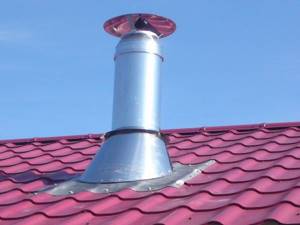
Bitumen tape
It is much easier to deal with roof leaks by making an apron from inexpensive bitumen tape. In addition to this material, you will need scissors, a torch and a metal brush. Bitumen tape can be used for any type of surface and section of the chimney, which distinguishes it from the same rubber. You are guaranteed at least two to three “dry” years on the treated areas. Durability depends on the intensity of precipitation, temperature changes and other atmospheric phenomena.
Using scissors, the tape is cut into pieces of the desired size. The outer lower part of the pipe and the area around it are thoroughly cleaned with a metal brush. Remaining dirt and dust are removed with a damp cloth. Pieces of tape are carefully glued to the joints. It doesn't matter where the slot is located. The chimney must be sealed around the entire perimeter. Thus, we will get a full-fledged apron like a metal one. To ensure that the bitumen tape adheres to the surfaces as tightly as possible, it is heated with a gas burner. For reliability, you can additionally use a wooden board or block. If the roof material allows, such fixation will be very useful.
Repairing a leak near a pipe
If, during precipitation or melting snow, water flows down the drain pipe or chimney, then the cause of the leak is a violation of the seal at the junction of the pipe and the roof. When a roof leaks near a pipe, you can fix the problem in one of the following ways:
- applying bitumen tape;
- installation of a rubber cuff;
- production and installation of a metal apron.
Bitumen tape
If a drain pipe or chimney is leaking where the roof passes, then the simplest and cheapest way to eliminate the leak is to form an apron from bitumen tape.
Roof sealing material
To work you will need:
- ribbon;
- scissors;
- metal brush;
- gas-burner.
You can seal the connection as follows:
- a metal brush is used to clean the roof around the pipe and the lower outer surface of the chimney (fan pipe);
- Use a damp cloth to remove any remaining dirt and dust;
- a piece of insulating tape is glued to the junction of the pipe and the roof with the bitumen layer down;
Applying waterproofing tape to the joint
- using a burner, the tape is heated and pressed against the surface of the roof and pipe;
- for greater reliability, the tape can be secured with a wooden board or block.
Rubber cuff
A more reliable method of eliminating a leak is to install a rubber cuff at the joint. For this:
- you need to purchase a special cuff;
- in the upper part, cut a hole equal to the diameter of the pipe being insulated;
- put the prepared cuff on the pipe;
- insulate the area where the cuff meets the roof with sealant;
- Screw the lower part of the cuff to the roof.
Instructions for installing a rubber cuff on a pipe
Pipe connection at the ridge
The easiest way to seal the joint between a pipe and a corrugated roof is if it is routed through a ridge. This increases the reliability of the connection. In such structures, the formation of snow pockets is impossible. The risk of leaks arises precisely when they are present. Such options also have one significant drawback - to pass the pipe through the top of the roof, the ridge element must be divided.
Attention! Often the space between the corrugated sheeting and the apron is filled with silicone-based sealant. Modern manufacturers offer consumers the use of self-adhesive tapes, which are made of butyl rubber.
We suggest you familiarize yourself with How to make a floor screed on a concrete base
The upper junction area must be sealed using the standard method - using the upper elements of the apron, sealed on top with sealant. The silicone composition is not afraid of high temperatures.
